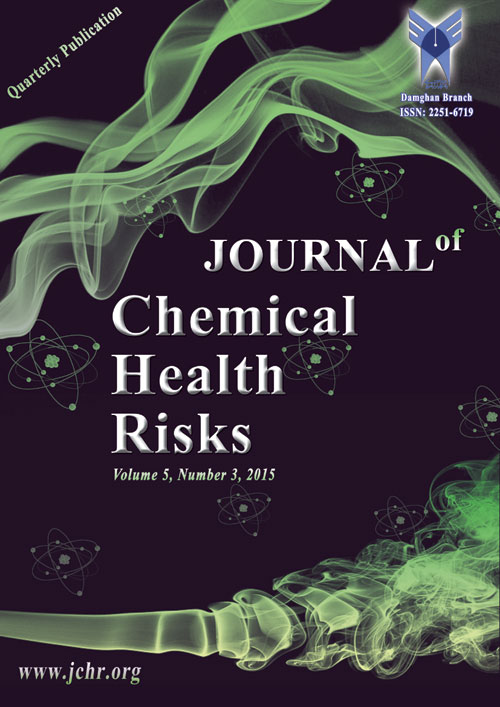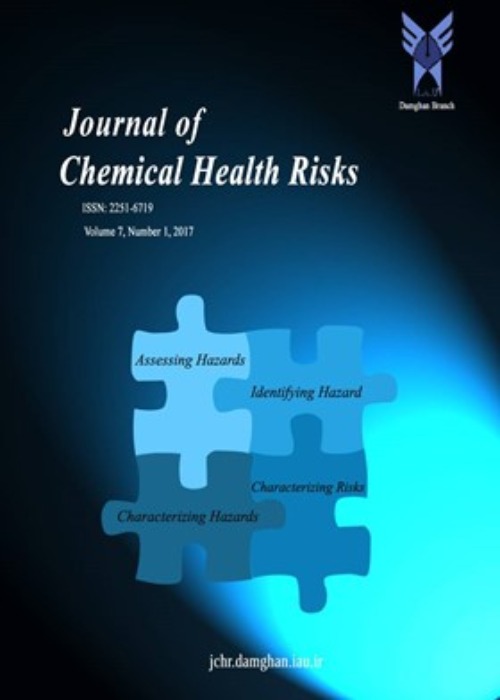فهرست مطالب

Journal of Chemical Health Risks
Volume:5 Issue: 3, Summer 2015
- تاریخ انتشار: 1394/04/16
- تعداد عناوین: 8
-
-
Page 155Large volumes of mostly irreparable electronic waste (e-waste) are shipped to Africa on a monthly basis, of which Nigeria receives the largest share. E-waste management practices in Nigeria have remained completely primitive until date; and e-waste workers have little or no occupational safety knowledge and devices. The thousands of chemicals in e-waste have been reported to be toxic to human health in any degree of exposure. The present study has assessed the risk of liver damage in workers occupationally exposed to e-waste in Benin City, South-south Nigeria in 2014. Serum activities of liver enzymes [alanine aminotransferase (ALT), aspartate aminotransferase (AST), gamma glutamyltransferase (GGT) and alkaline phosphatase (ALP)]; and levels albumin (ALB), total bilirubin (T/Bil) and conjugated bilirubin (C/Bil) were determined using standard colorimetric methods. Serum Alpha fetoprotein (AFP) was determined using ELISA in Nigerian e-waste workers (n=63) and in age-matched unexposed participants (n=41) in Benin City. The results showed significantly raised activities of enzymatic biomarkers of liver damage (ALT, AST, ALP and GGT) in the e-waste group compared with the unexposed participants. There was no significant difference in the levels of ALB, T/Bil and C/Bil between exposed and unexposed participants. AFP levels in e-waste workers (3.56 ± 0.34 ng/mL) were significantly different compared with the unexposed group (2.14 ± 0.80 ng/mL) (P< 0.045). The significantly elevated cancer risk biomarker (AFP) and the enzymatic biomarkers of liver damage observed in the Nigerian e-waste workers studied may be associated with occupational exposure to known carcinogens and hepatotoxic metals in e-waste.Keywords: E, waste, Nigeria, Liver damage, Occupational exposure
-
Page 167Xanthan gum is an extracellular polysaccharide produced by various Xanthomonas species such as X. campestris. The objective of present study was to investigate the influence of different carbon and nitrogen sources on xanthan gum production by X. campestris. Using an experimental Response Surface Methodology (RSM) complemented with a Central Composite Design (CCD), the impact of peptone, lactose, glucose and ammonium nitrate in medium were estimated for their individual and interactive effects on biomass and xanthan gum production. The optimal concentrations of peptone, lactose, glucose and ammonium nitrate for xanthan gum yield and biomass production was determined as 9.25 g/l, 53.37 mmol, 29.31 mmol and 4.58 g/l for xanthan gum yield and 6.77 g/l, 52.65 mmol, 38.12 mmol and 3.54 g/l for biomass production. Under the optimum experimental conditions, the xanthan gum yield reached to its maximum value (8.42 g/l). The results provide the support data for xanthan gum production on a large scale.Keywords: Xanthomonas cam, pestris, Xanthan gum, Response surface methodology, Carbon sources Nitro, gen sources
-
Page 179Heavy metals, e.g. Cd and Pb emit and release into the environment during cement production and are deposited into soils. This research was carried out to determine the concentration and spatial distribution of trace elements in top soils around the Kurdistan Cement Factory, west of Iran in order to evaluate the effect of cement factory on the environment. Twenty-four soil samples were collected from surface soils around the factory. Cadmium and lead concentrations in soil samples were determined using acid extraction procedure and atomic absorption spectrophotometric methods. Soils were sampled in four directions of north, south, west and east of cement factory and at intervals of 400 m to 800 m distance from the factory. Ordinary kriging technique in ArcGIS was performed to map the spatial patterns of heavy metals. The results showed that concentrations of Pb and Cd were weakly correlated with each other indicating these metals in soils may be from the different pollution source. No distinct spatial trends of Pb with its low accumulation in the soils demonstrate that Pb content was mainly influenced by soil factors. The spatial pattern of the cadmium showed that the cement factory emission has an impact on the soil’s cadmium content, since the highest level in area close to the cement factory. Estimated Pollution Load Index (PLI) showed that the soils around the factory were practically uncontaminated by metals.Keywords: Metals, Cement, Soil, Spatial analysis, Iran
-
Page 193Nanotechnology researchers have identified a wide range of nanoparticle applications that may have an important role in medicine and treatment of diseases. Due to lack of detailed documentation about the toxicology of zinc oxide (ZnO) nanoparticles, this study was aimed to evaluate the absorption of ZnO nanoparticles in hearts of female NMRI mice. Overall, 20 adult NMRI female mice were studied in experimental and control groups. ZnO nanoparticles with concentration of 100 and 300 mg/kg were administered in the drinking water for 28 days and the mice were dissected after 28 days. Then, the heart tissues were isolated and dissolved in acid and the amount of ZnO deposited into the heart tissue was measured by atomic absorption spectrophotometer. ZnO nanoparticles treatment groups were significantly influenced by the nanoparticles compared with the control group. The experimental group 1 and 2 had a significant increase in ZnO NPs absorption in heart tissue compared to the control group (P<0.01). Due to the physiological similarities between mice and humans, the results of this study can be applied in prevention of the cardiac damage during the consumption of ZnO NPs.Keywords: Nanoparticles, Zinc oxide (ZnO), Heart, Absorption
-
Page 199Contamination of soil was investigated in this study from the Tehran Oil refining Co. of Iran. Fifteen soil samples were collected at several points in the Azimabad, 15 km south of Tehran City, Iran. Samples were collected at depths of 0–30 cm. Control sampleswere prepared to determinebackgroundlevels ofsoil contamination with petroleum hydrocarbons for comparison with contaminatedsites. Total petroleum hydrocarbon (TPH) and poly-aromatic hydrocarbons (PAH) concentrations varied from 101334.0–101367.1 and 25321.1–25876.6 mg kg-1 respectively. The results elevated levels of TPH and PAH contents when compared with the control sample. Soil acidity (low pH of 5.3–5.9) and low electrical conductivity provided evidence of reduced metabolic activities on the affected site.Microbialgrowthrates for bacteria and fungi expressed as colony forming units were 2.62×109 and 4.14×106CFU/g soil, respectively for the contaminated and 5.76×109 and 6.83×106CFU/g soil, for the control treatments respectively. These drastic changes can have impact on the nutrient cycle and prevents the absorption of nutrients by plant root sand lead to a reduction in yield.Keywords: Petroleum waste spill, Petroleum hydrocarbons, Soil contamination, Microbial population
-
Page 209The present study investigated the effects of acute toxicity of malathion on behavioral and haematological parameters in the cyprinid Capoeta damascina. The specimens were collected from the Kordan River, Karaj, Iran in August, 2014 and were exposed to different concentrations of malathion at the laboratory (24, 48, 72 mg L‑1) based on 96h-LC (10; 30; 50; 90) which was 6.08 (5.22-7.18) mg L-1. The animals were then exposed to 0.76, 1.00 and 1.52 mg L-1 of malathion for 10 days. Blood samples were collected in days 1, 5 and 10. Red blood cell (RBC), white blood cell (WBC), hemoglobin (Hb), hematocrit (PVC), mean corpuscular volume (MCV), mean corpuscular hemoglobin (MCH), and mean corpuscular hemoglobin concentration (MCHC) were measured. Behavioral abnormalities were observed in fishes exposed to high levels of malathion. The specimens exposed to malathion had significantly lower RBC, WBC, Hb, PVC but higher MCV and MCH than those of the control group. No significant difference was detected in MCHC the exposed and control specimens. Hematological parameters (except MCHC) were significantly correlated with exposure time. In conclusion, malathion showed extensive haematological effects on C. damascina that might be used as bioindicator of this pesticide in flowing waters.Keywords: Malathion, LC50, Capoeta damascina, Haematological parameters Behavioral changes
-
Page 221Chemical stabilization of heavy metals is one of the soil remediation methods based on the application amendments to reduce mobility of heavy metals. A laboratory study was conducted to investigate the influence of different kinds of amendments on cadmium (Cd) stabilization in a Cd-spiked soil. The amendments were municipal solid waste compost (MSWC), Coal fly ash (CFA), rice husk biochars prepared at 300°C (B300) and 600°C (B600), zero valent iron (Fe0) and zero valent manganese (Mn0). The Cd-spiked soils were separately incubated with selected amendments at the rates of 2 and 5% (W/W) for 90 days at 25 °C. Soil samples were extracted by EDTA for periods of 5 to 97 min. In addition, sequential extraction was used as a suitable method for identification of chemical forms of Cd and their plant availability. The addition of amendments to soil had significant effects on desorption and chemical forms of Cd. Changes in Cd fractions and their conversion into less soluble forms were clear in all treated soils. The addition of amendments resulted in a significant reduction in mobility factor of Cd compared to the control treatment. Among all amendments tested, Fe0 was the most effective treatment in decreasing dynamic of Cd. Biphasic pattern of Cd desorption kinetic was fitted well by the model of two first-order reactions. In general, from the practical point of view, Fe0, MSWC and Mn0 treatments are effective in Cd immobilization, while application of Fe0 at 5% (W/W) was the best treatment for stabilization of Cd.Keywords: Cadmium, Stabilization, Amendments, Soil
-
Page 235This study was performed to assess the effects of nitrogen fertilizer and vermicompost on qualitative and quantitative yield of chamomile (Matricaria chamomilla L.). It was conducted at the Research Fields of Ran Company located in Firouzkouh, Iran, in 2013. Treatments were consisted of 1) Control, 2) 100% nitrogen from urea, 3) 100% nitrogen from ammonium nitrate, 4) 75% nitrogen from urea and 25% from vermicompost, 5) 75% nitrogen from ammonium nitrate and 25% from vermicompost, 6) 50% nitrogen from urea and 25% from vermicompost, 7) 50% nitrogen from ammonium nitrate and 25% from vermicompost, 8) 25% nitrogen from urea and 25% from vermicompost, 9) 25% nitrogen from ammonium nitrate and 25% from vermicompost, and 10) 100% nitrogen from vermicompost. The maximum plant height (67.03 cm) and plant weight (93.21 g/plant) were obtained at N2 treatment (200 kg ha-1 urea). N5 treatment (202.5 kg ha-1 ammonium nitrate + 1.5 ton vermicompost ha-1) caused maximum flower diameter. The highest fresh flower yield (7539.45 kg ha-1), dry flower yield (1715.93 kg ha-1) and essential oil yield (6.95 kg ha-1) obtained in plots, which received 135 kg ha-1 nitrate ammonium + 3 ton vermicompost ha-1. It seems using biofertilizers such as vermicompost could enhance quantitative and qualitative characteristics of chamomile. Moreover, by substituting chemical fertilizers by biofertilizers, ecosystem health and quality of life will increase which it is the most important goals of sustainable developments.Keywords: Vermicompost, Chamomile, Nitrogen, Essential oil


